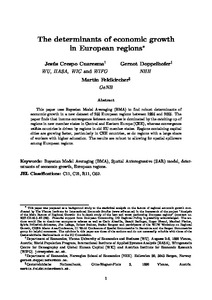The determinants of economic growth in European regions
"We use Bayesian Model Averaging (BMA) to evaluate the robustness of determinants of economic growth in a new dataset of 255 European regions in the 1995-2005 period. We use three different specifications based on (1) the cross-section of regions, (2) the cross-section of regions with country f...
| Main Authors: | , , |
|---|---|
| Institution: | ETUI-European Trade Union Institute |
| Format: | TEXT |
| Language: | English |
| Published: |
Munich
2009
CESifo |
| Subjects: | |
| Online Access: | https://www.labourline.org/KENTIKA-19188123124919063059-The-determinants-of-economic-g.htm |
| Summary: | "We use Bayesian Model Averaging (BMA) to evaluate the robustness of determinants of economic growth in a new dataset of 255 European regions in the 1995-2005 period. We use three different specifications based on (1) the cross-section of regions, (2) the cross-section of regions with country fixed effects and (3) the cross-section of regions with a spatial autoregressive (SAR) structure. We investigate the existence of parameter heterogeneity by allowing for interactions of potential explanatory variables with geographical dummies as extra regressors. We find remarkable differences between the determinants of economic growth implied by differences between regions and those within regions of a given country. In the cross-section of regions, we find evidence for conditional convergence with speed around two percent. The convergence process between countries is dominated by the catching up process of regions in Central and Eastern Europe (CEE), whereas convergence within countries is mostly a characteristic of regions in old EU member states. We also find robust evidence of positive growth of capital cities, a highly educated workforce and a negative effect of population density. " |
|---|---|
| Physical Description: | 37 p. Digital |

